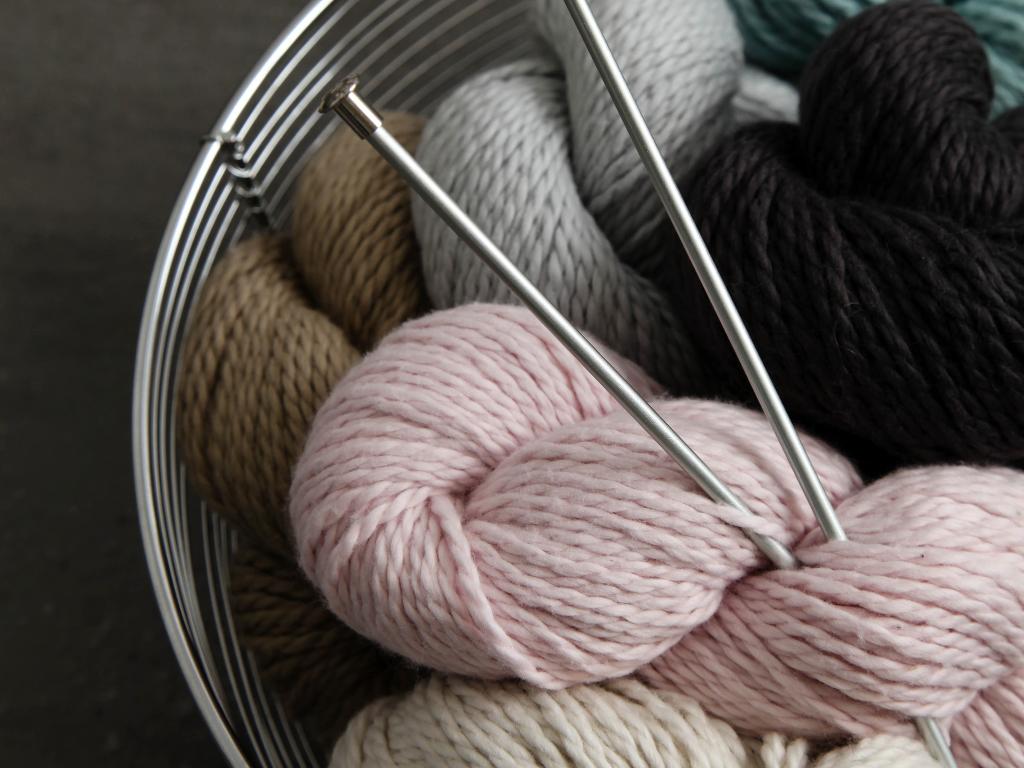When we covered how to hand dye animal fiber yarn like wool and alpaca back in January, several Craftsy members had questions about hand dyeing cotton yarn, too. Craftsy to the rescue! Hand dyeing cotton yarn —and any other yarn for that matter —gives you an endless rainbow of colors that you may not be able to find in your local yarn store. Grab those blah-hued hanks and let’s talk about hand dyeing cotton yarn to turn it into an artsy fiber masterpiece!

Blue Sky Alpacas Worsted Cotton yarn
Cotton vs. wool
You might ask yourself, why do I need to know about cotton if I already read about dyeing wool? Don’t forget that wool is an animal fiber. Cotton yarn, as you may know, is a plant fiber. Plant fibers behave just a little bit differently than animal fibers, so we need to treat them differently when dyeing them. This not only ensures that we get a gorgeous color, but it also ensures that the beautiful color lasts through wearing and washing.
Prepping your yarn and space
Tying yarn into hanks
You don’t want the yarn to get all tangled up during dyeing, so tie it in a loose hank to hold it all in place. This will also ensure the entire hank is dyed the same color evenly. If you’re not sure how to tie yarn into a hank, see our post on washing coned yarn. There’s a small tutorial for tying yarn into a hank there. And if your yarn is already in a hank, then skip this step and start washing!
Washing yarn
Before you start the actual dyeing, you’ll need to wash your yarn to remove any kind of residue, including wax and other yucky stuff. Here’s how:
1. Place the cotton into a large saucepan, then add some mild soap. Pour in warm water until it just immerses the entire hank of cotton. Place the saucepan on the stovetop, then turn the heat to simmering. Simmer the cotton for about an hour.
2. Once the cotton is ready, rinse it and let it dry. You may notice that the water turns a bit brown. That’s totally normal, so just keep rinsing until the yarn rinses clear.
Rowan Siena mercerized cotton yarn
Choosing dye
Different types of dye work differently on each type of yarn. So just because you dyed that wool a beautiful purple with one dye doesn’t mean it will dye the same beautiful purple on cotton. Kool-Aid, for example, is great for dyeing animal fibers, but it won’t work on cotton or other plant fibers.
One of my favorite dyes to use on cotton is dye intended for tie-dye. Most T-shirts we tie dye are made from 100% cotton, right? So any dye that’s appropriate for a 100% cotton T-shirt is also appropriate for dyeing cotton yarn. I know quite a few knitters and crocheters who had luck with Tulip’s One-Step Tie-Dye Kit, but check your local craft store’s T-shirt dye aisle and you’ll find plenty of options there. (And yes, you can totally tie-dye your cotton yarn!)
And another note regarding different types of fiber: Remember that some cotton yarns are mercerized. Check out the Rowan Siena yarn pictured above. Notice how the fibers are a bit shiny? That’s because the cotton is mercerized. This type of cotton will take dye differently than cotton that has not been mercerized. But, don’t worry if you’re not confident about identifying mercerized cotton on your own. The yarn label will always specify that the cotton has been mercerized, so you’ll know before you dye.
Dyeing methods
There are a lot of dyeing methods floating around out there, but I’ve found that dye kits and liquid RIT dyes are among the easiest to navigate. Here’s the method I use with my liquid RIT dye — and remember that it’s just one of many dyeing methods for cotton yarn.
Directions
1. Pop on those rubber gloves. Fill a pot with enough water to cover your hank of yarn. The yarn should be able to swish around in the pot and still be covered by water.
2. Heat water until it simmers. Do not let the water heat to a boil.
3. Add dye to the water. Check your dye’s instructions to see how much dye is recommended. Remember that using too little dye will result in a lighter color and vice versa. Sometimes you may want to purposely alter the amount of dye to achieve a certain color.
4. Add up to a cup of salt to the water. This will keep the color from fading.
5. Add the yarn to the water. (It should be slightly wet at this point after its washing.) Using a metal spoon, move the yarn around in the pot for about half an hour. Moving the yarn ensures the dye saturates the fiber evenly.
6. Remove the yarn from the water. Rinse the yarn in warm water, gradually making the water temperature colder as the water starts to run clear.
Easy, yeah? Don’t forget to experiment with different dye and dyeing methods to figure out which one works best for you. Experiment with different types of cotton, too! I bet you’ll be totally addicted to dyeing after a few rounds.


Share tips, start a discussion or ask one of our experts or other students a question.
Already a member? Sign in
No Responses to “Hand Dyeing Cotton Yarn Into An Artsy Fiber Masterpiece”